#loch rannoch
Explore tagged Tumblr posts
Text

2 notes
·
View notes
Text
Lofty Lochs: Understanding Scotland’s Deepest Lochs
With over 30,000 sparkling lochs, there’s no shortage of blue spaces in Scotland, meaning that Scots and tourists alike have year-round opportunities for safe wild swimming in Scotland – if they can brave the cold, that is! Scotland’s lochs are full of crevices, underwater currents, and even rumoured creatures like the Loch Ness Monster. So, it’s crucial that those choosing to swim or participate in watersports in Scotland’s lochs understand the complexity and grandiosity of what goes on beneath the surface to ensure water safety.
We’ve pulled together a list to show you exactly how deep Scotland’s lochs plunge below the surface by comparing them to iconic landmarks and structures from across the globe.
Loch Morar - Lochaber

So, what is the deepest loch in Scotland? Loch Morar in the Lochaber area of the Highlands takes the crown. At its deepest point, the loch reaches depths of around 310 metres – deeper than most of the seabed off Scotland’s west coast! That’s the same height as The Shard building in London (the tallest building in the UK), or about 69 Great White Sharks stacked from nose to tail. Not only is Loch Morar the deepest loch in Scotland, but it is also the third deepest loch in Europe. Loch Morar has plenty of safe entry points for wild swimming and watersports, but many swimmers prefer to take advantage of the white sandy beaches and crystal blue waters of the nearby Silver Sands of Morar.
Did you know? According to local legend, it is even home to a mysterious creature known as Morag, who is said to resemble Loch Ness’ Nessie.
Loch Ness - Scottish Highlands

Not only is Loch Ness perhaps Scotland's most well-known loch, but it is also Scotland's second-deepest loch and our largest loch by volume. Just how big is Loch Ness? Well, at its deepest point, Loch Ness is around 230 metres – about the same height that the Golden Gate Bridge in San Fransisco, California, sits above water! You would also have to stack about 65 Adult African Elephants (with an average size of 3.5 m), one on top of the other, before reaching the bottom of Loch Ness. Let's hope Nessie, the Loch Ness Monster, welcomes guests! If you fancy going wild swimming, we recommend Urquhart Castle on the west side of the loch. Visitors can enjoy a day dipping in the loch as the Scottish sun beats down through the castle ruins. Having undergone a £1.5 million refurbishment, make sure to also check out The Loch Ness Centre when it reopens on 10 June. There is even a brand-new tour to enjoy - not to be missed!
Did you know? Loch Ness contains more freshwater than all the lakes in England and Wales combined!
Loch Lomond - Loch Lomond

The third deepest loch in Scotland is another one of the country's best-known lochs, Loch Lomond. Loch Lomond sits significantly further south than Loch Morar and Loch Ness, just around 30 minutes from Stirling and Glasgow. Loch Lomond is about 190 metres at its deepest point, or the equivalent of stacking two of New York's Statue of Liberty monument on top of each other before reaching the bottom! For a more everyday comparison, that's about 190 washing machines stacked on top of each other. For those looking to venture into open water swimming in Scotland through an organised event, Loch Lomond also has an annual swimming event that takes place every September called Go Swim. The event is an excellent way to experience wild swimming, regardless of swimming level, safe in the knowledge that you're surrounded by experts. When exploring the waters of Loch Lomond, visitors should be mindful of the steep drops close to the shoreline.
Did you know? Interestingly, Loch Lomond is also the biggest loch in the UK by surface area, spanning a whopping 71 sq km and 36 km long.
Loch Lochy - Lochaber

The Scottish loch with the easiest name to remember (or most unoriginal name) is Loch Lochy. It is the fourth deepest loch in Scotland and is located in the Lochaber region of the Highlands. At its deepest point, Loch Lochy reaches depths of approximately 162 metres; that’s about the same as four Boeing 737-800 planes (at around 40m each) stacked from tail to nose! Or approximately the same as a tower made of 16,875 standard LEGO bricks. Nearby to the lighthouse on Loch Lochy, there’s a lovely stone beach that makes for an excellent entry and exit point for wild swimming in the freshwater loch.
Did you know? Early Gaelic translations of the name ‘Loch Lochy’ roughly translate to mean ‘loch of the dark goddess’.
Loch Rannoch - Perthshire

Loch Rannoch in the Perthshire region of Scotland is our eighth deepest loch, with the deepest recorded depth at around 130 metres. That's about the same in depth as the London Eye is in height. In comparison, that's also roughly the same as about 30 average-sized double-decker buses stacked! Much like Loch Tay, Loch Rannoch is also home to a Crannog (artificial island) that was used in the 18th century as a base for the outlawed members of the MacGregor Clan. The expansive sandy shores of Loch Rannoch mean you could easily have miles of the watery world to yourself. However, for those who are perhaps less experienced in plunging into cold waters, Loch Rannoch has plenty of watersports opportunities where an expert can support you.
Did you know? Loch Rannoch is also an excellent place for wildlife spotting, with animals such as red squirrels, pine martins, otters, capercaillie, and red deer in abundance in the surrounding Rannoch region.
Loch Shiel - near Glenfinnan

Scotland’s ninth deepest loch, Loch Shiel, comes in at about 120 metres in depth – or about the same height as the Glasgow Tower that towers over the city of Glasgow’s skyline. For any basketball fans out there, that’s roughly the same as about 64 professional NBA players stacked! And what’s a Scottish loch without a resident monster? Loch Shiel is said to be home to a mythical creature known as Seileag. Seileag is said to be an enormous eel that lived in the ocean but sometimes entered the lochs. Loch Shiel stretches as far as the eye can see, and the mountains tower steeply above the shores, meaning exploring it by water will give you a whole new perspective to take in its awe-inspiring beauty.
Did you know? The loch has been used as a backdrop of the Hogwarts school in the Harry Potter films and for the scenes where the characters are at the ‘Black Lake’. For those looking to explore more of the Harry Potter filming locations, check out our film and book itinerary.
Loch Maree - North West Highlands

Loch Maree might just be our most beautiful loch. With a maximum recorded depth of 112 metres, Loch Maree is about the same in depth as two Leaning Towers of Pisa in Italy would be in height, if you could stack two on top of each other. Or, about the same as 991 cans of soda stacked on top of each other. Tollie Bay on the loch is a favoured spot for wild swimmers and watersports enthusiasts, but Loch Maree’s real water attraction lies in its scattered islands. The islands on Loch Maree are some of the least disturbed by human places in the UK, and, as such, the habitats of the island support many extremely rare species of plants, insects and birds. For those looking to paddle over to the islands, it is crucial to do so responsibly in line with the local access guidance to minimise impacts on the protected wildlife.
Did you know? Loch Maree is another loch said to be the home of a monster, so wild swimmers should beware! Muc-sheilche (which loosely translates to “turtle-pig”) is said to live in the Loch Maree and the nearby lochs.
Loch Arkaig - Lochaber

Last but by no means least, we have Loch Arkaig. Tucked away between Fort William and Inverness, it is Scotland's eleventh deepest loch. Loch Arkaig plunges to depths of roughly 91 metres and is as deep as the Forth Bridge is at its highest point above water. For scale, this is approximately the same as 7,267 Jenga blocks stacked! Arkaig is a hidden gem tucked away off the beaten track with many water wellness experiences for visitors to enjoy. Wild swimming explorers can dip into the loch or head to explore the waterfall at Cha-aig to plunge into the chilly waters of one of the waterfalls' pools.
Did you know? Rumour has it that Loch Arkaig is home to some hidden treasure. In 1745, seven caskets of gold came to Scotland from Spain to finance Bonnie Prince Charlie's Jacobite uprising in Scotland. But by the time the gold arrived, the war was already over.
#nature#water#Scotland#lochs#infographic#macro#loch morar#lochaber#loch lomond#loch ness#loch lochy#loch rannoch#loch shiel#Glenfinnan#loch marer#Scottish Highlands#loch arkaig
0 notes
Photo
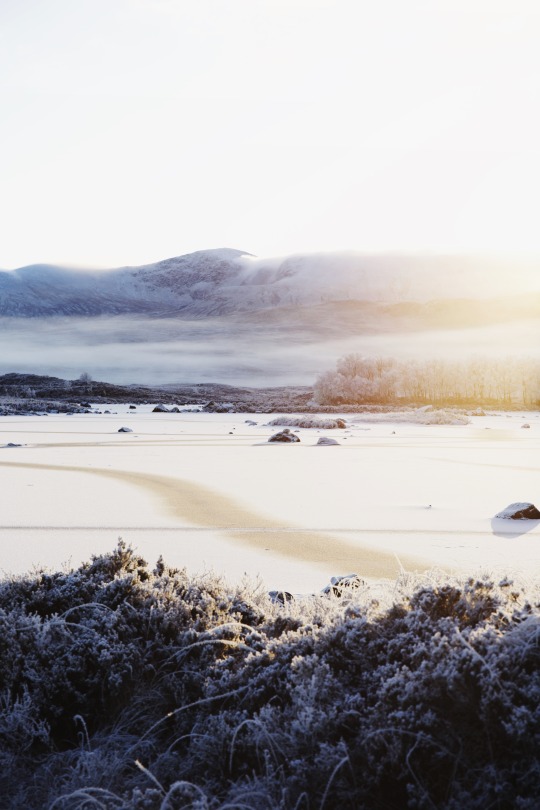
Loch Ba by Kyle Bonallo (ig: @kylebonallo)
630 notes
·
View notes
Text
The pass [Glencoe]is an awful place. It is shut in on each side by enormous rocks from which great torrents come rushing down in all directions. In amongst these rocks on one side of the pass ...... there are scores of glens, high up, which form such haunts as you might imagine yourself wandering in, in the very height and madness of a fever.
Attributed to Dickens by JOHN FORSTER, The Life of Charles Dickens (1872)
FOUR YOUTHS in hoodies chase the Glasgow pigeons as we queue for the bus to Fort William, and two Irishmen behind us argue over whether knocking fish on the head facilitates landing them. It makes them jump higher, says one. His wife tells him not to put his sausage roll in his pocket, but to eat it there and then.
An elderly man stoops over a walking stick, of the kind issued in hospitals. He wears slip-on grey sneakers, and a cigarette dangles from the left of his mouth. He inhales hands-free.
It’s Buchanan Street. It could be Pyong Yang. The portrait of the recently deceased Queen Elizabeth is everywhere you look, her obituary emblazoned in LED on every bus.
A dozen comics waddle past us waving Union flags. We board the bus, for which there appears to have been a block booking for an Orange lodge.
Before long we’re making our way up the western bank of one of Europe’s most celebrated stretches of water, Loch Lomond. Luckily, I’ve a window seat on the right, and can savour the scenery rather than listen to the Rangers video one of the Masons is watching on his phone while his mates snore. Loch Lomond has 37 islands. One has escapee wallabies; another has a nudist camp; yet another’s yew trees provided the wood for Bruce’s bows at the Battle of Bannockburn. It is the only substantial yew wood in Scotland.


Sir Walter Scott’s influence on tourism was described by Alexander Smith in Summer in Skye as long ago as 1865: 'As soon as The Lay of the Last Minstrel appeared, everybody was raving about Melrose and moonlight. He wrote The Lady of the Lake and next year a thousand tourists descended on the Trossachs, watched the sun setting on Loch Katrine, and began to take lessons on the bagpipe. . . . . Where his muse was one year, a mail-coach and a hotel were the next.'
In September 2024, though, Flamingo Land was refused planning permission for a £40 million tourism complex on a disused shunting yard near Balloch at the southern end of the loch. There was a 175,000- name petition against plans for a resort that would have included woodland lodges, two hotels, a monorail, and a water park.
The Dumbarton Democrat ventured: 'Planning application for Flamingo Land is a preposterous proposal which should be refused. It would be like putting the Scottish National Orchestra on the same concert programme as the Bay City Rollers.'
In December 2017 the five-star Cameron House Hotel, on the western bank of the loch, was gutted by fire after a porter placed hot ashes in a cupboard next to kindling. Two people were killed, and the hotel, which had hosted Churchill, Princess Margaret, Mountbatten and Samuel Johnson, was closed for three years.

The original castle built on the site of Cameron House had been occupied by the Earls of Lennox. In 1763, it was bought by the family of Tobias Smollett, born in nearby Renton, whom George Orwell reckoned was ‘Scotland’s best novelist’. Smollett is quoted as saying: 'I have seen Lake Garda, Albana, de Visco, Bolsetta and Geneva. Upon my honour I prefer Loch Lomond to them all.'

What became the grounds of Cameron House were once home to 32 bears. The Cameron Bear Park, which opened in 1972, featured a zoo garden, which was very popular with visiting children. I recall, also, attending a rock concert there in the 1980s.
Back on the northbound bus I fall asleep and dream of tourists snapping marsupials on their mobiles as they hopped about the Scottish glens. The late Lady Arran Colquhoun, whose son now sits in the House of Lords, originally bred them on Inchconnaghan island in Loch Lomond in the 1940s. She later became famous as the ‘fastest granny on water’ after reaching 103mph in a power boat on Lake Windermere in the 1980s. Some of the wallabies managed to get to the mainland and were knocked down by vehicles whose drivers were baffled to see the outlandish creatures. They remain feral, although a petition has been raised to save them following the sale of the island to showbiz's Kirsty Young, who proposed relocating them.


As I wake up the bus begins to negotiate Rannoch Moor, east of Glencoe, through some of the most haunting scenery imaginable, although many writers have recoiled from it.
Glencoe, reputedly the birthplace of the poet Ossian, is reminiscent of Switzerland; and it evokes tales of buried giants and inconsolable ghosts. Its supernatural grandeur robs me of words, as it did Lord Cockburn: 'I will not attempt to describe what is so common, and is yet superior to all description. It is the Switzerland of Scotland.'
The literati loved or loathed the glen. Dorothy Wordsworth, who went on a six-week tour of the Highlands with her brother William, and the ailing Samuel Taylor Coleridge, called it ‘a wild and solitary spot’. William Gilpin, a Cumberland curate who became one of the founders of the ‘picturesque’ school of travel writing, wrote: 'Glencoe is … one of the most interesting scenes in the whole country, hung with rock, and wood; and abounding with beauties of the most romantic kind' (Observations, relative chiefly to picturesque beauty, made in the year 1776, on several parts of Great Britain; particularly the Highlands of Scotland, 1789) .

In his book The Wild Places Robert McFarlane, the naturalist and travel writer, travelled Glencoe and wrote of Rannoch: 'Many know the Moor … but relatively few enter it, for it is vast and trackless and has a reputation for hostility at all times of year'.
And T S Eliot penned the following poem:
Here the crow starves, here the patient stag
Breeds for the rifle. Between the soft moor
And the soft sky, scarcely room
To leap or soar ...
‘Rannoch by Glencoe’
The poet Robert Southey recoiled from Glencoe’s ‘savage and terrible grandeur’: 'It admits of no comparison ; it has a grand character of desolation, not to be found in our happier Land of Lakes.'
The American travel writer Nathaniel Carter saw Glencoe’s ‘solitary, gloomy and romantic wildness’ and believed the scenery surpassed anything he had witnessed in Scotland. 'It is composed of perpendicular belts of dark cliffs, piled one upon another, till the top is literally lost in the clouds, which are constantly breaking upon the rocks and feeding torrents that tumble into the vale below,' he observed in his Letters from Europe (1829).
Charles Dickens considered it ‘perfectly terrible … an awful place’, and wrote to his friend, John Forster: 'If you should happen to have your hat on, take it off that your hair may stand on end.'
For the celebrated Dickens, Glencoe would live in his dreams for as long as he lived. The very recollection of it made him shudder. The Rev. James Hall, chaplain to the Earl of Caithness, was scared by it, too: he referred to Glencoe as ‘the dreary and dreadful pass’ with its ‘gloomy precipices and the ‘savage rudeness of the mountains’. Nor was the historian Thomas Macaulay impressed: 'The most dreary and melancholy of all the Scottish passes – the very Valley of the Shadow of Death.'
Passengers on the bus take photographs from their seats, as I avert my eyes from the wrecked house that the demonic Jimmy Savile used as an infrequent bolt hole. The cottage, on the approach to Glencoe, is vandalised and derelict, with slogans denouncing the disgraced paedophile, who died in 2011. Someone set it on fire in September, 2004. Harris Islam, the billionaire Kirkcaldy-based retail tycoon, who now owns it, wants to bulldoze it and erect a museum to the late mountaineer Hamish McInnes, who sold it to Savile, not knowing what he really was. Others want it to be ‘flattened and rewilded’.


The massacre in Glencoe is one of the most talked about atrocities in our bloodstained land: the culmination of a government plot to bring Highlands clans to heel in the years after William of Orange had ousted King James. Thirty-eight members of the MacDonald clan were murdered in February 1692 by soldiers led by a Campbell.
The massacre was condemned by several writers, including James Johnson, a verbose Irish surgeon and advocate of ‘climate therapy’, in his book, The Recess, or Autumnal Relaxation in the Highlands and Lowlands ; being the Home Circuit versus Foreign Travel , a Tour of Health and Pleasure to the Highlands and Hebrides (1834): 'There is no valley or spot in the Highlands that can make much pretension to the sublimity of Alpine scenery or solitude except Glenco. The cliffs, crags, and steeps that rise in rude and barren majesty, some two thousand feet , on each side of this narrow valley or ravine, appear like the gigantic ribs of some huge earth-born monster from which time and tempest had long swept away every thing but the solid granite bones.
'The scenic phenomena produced the annals of crime and the history of mankind (which are nearly synonymous) there is not a more revolting example of infamy and cruelty than this sequestered and romantic valley has put on deathless record! Even in these degenerate days , we can scarcely credit the astounding and tragic fact, that the hero of our ‘glorious revolution’ should have signed and countersigned worse than the edict of Nantes.'
In 2015 lines from Sir Walter Scott’s poem about the massacre were beamed on to hillsides by Edinburgh-based Double Take Projections to mark the 300th anniversary of the 1715 Jacobite uprising.
Rannoch Moor is a place of wonder: one of Europe’s last wildernesses – fifty square miles of blanket bog, lochans, rivers, and rocky outcrops.
Robert Louis Stevenson’s view of Rannoch Moor in the novel Kidnapped was: 'A wearier looking desert a man never saw.'
In his collection of letters to Sir Walter Scott, published as The Highlands and Western Isles of Scotland (1824), John Macculloch, evidently not one for majestic scenery, dismissed the staggeringly beautiful moor as a Serbonian bog’: 'All, every beauty, every thing, vanishes before we reach the King’s House; where the hideous, interminable, open moor of Rannoch is spread before us, a huge and dreary Serbonian bog, a desert of blackness and vacuity and solitude and death; the death of nature.'
He must have found it on a bad day.
0 notes
Text



This happened, Stuart, husband of Lynn, met Sam at the Loch Rannoch hotel. He called his wife and she talked with Sam on the phone.

According to Stuart, filming isn't entirely done yet as this was posted yesterday, Tuesday 1 October!
61 notes
·
View notes
Text
Exploring 2024 SDCC
Greetings all!
Before 2024 San Diego Comic-Con fades in the rear view mirror, I want to share some of the things I have learned and experienced about SDCC over the years.
I attended my first DSCC in 2017. I had intended to go in 2016 but my husband planned a surprise trip to Scotland in honor of our 53rd wedding anniversary!
No complaints because I had a grand time. Don’t want to get distracted from my mission, but here’s a few photos to explain why I chose Scotland in 2016.
We visited the stand in for Craigh na Du. A lovely, quiet, tree-covered mound with a lot of sheep. In the distance you can see Loch Rannoch (photo, left), the site where Claire and Ned Gowan (ep 105) quote from the poet John Donne.

Next is the shop window where Claire contemplates buying a pair of vases (ep 101). The site was supposedly Inverness but the filming actually took place in the village of Falkland in Fife. I have too many links to share the entire post here, so please visit us on the blog. I promise you'll enjoy the read and pics!
A deeply grateful,
Outlander Anatomist
13 notes
·
View notes
Text



Alexander Robertson of Struan bnner at Perth Museum.
Alexander was 13th Chief of Clan Donnachaidh, and, according tothe info board, a "dangerous" Jacobite.
Robertson succeeded his father as 13th Chief of Clan Donnachaidh in 1687 and left his studies at the University of St Andrews to join the rising in support of King James VII two years later, fighting alongside John Graham of Claverhouse , Bonnie Dundee or Bluidy Clavers, depending on where your loyalties lay.
Robertson was taken prisoner a few weeks after Battle of Dunkeld in 1689. He was later released but followed his King to France, into exile and became established at the Jacobite Court in St. Germains, remaining there for thirteen years.
He served some time in the French army.before returning to Scotland in 1703. In 1715, he led a force of 500 of his clansmen in support of John Erskine, the 6th Earl of Mar at the Battle of Sheriffmuir. He was again taken prisoner, but later rescued and returned to France.
He wasn't just a soldier though, although not completing his studies at St Andrews Robertson was well educated and his periods of exile gave him time to write poetry in several languages, including English, Gaelic, French, Italian and Latin.
Unsurprisingly, Robertson was a supporter of Bonnie Prince Charlie and the Jacobites in the '45. He was by then in his mid 70's, but despite his age, he led his clansmen at the Battle of Prestonpans.
After the Jacobite victory, Robertson took as prizes a gold chain, wolf-fur cloak, brandy and a carriage which had belonged to the defeated commander, Johnny Cope. His clansmen escorted him back home in the coach, savouring their success. When the wheel of the coach broke, they carried both Robertson and the coach for the last few miles of the journey.
Folloing the heartache with the defeat at Culloden, his home at Dunalastair was torched by government troops and his estates were forfeited. However, given that Robertson was an old man who was very popular with his clansmen, and had taken only a very limited part in the fighting, the government was in no hurry to oust him and only took over the running of the estate after his death.
Robertson never married, indeed he was a notorious misogynist who enjoyed the 'good life', reciting his own, often rude, poetry to friends and drinking heavily. His portrait as seen in the third pic, held by the National Gallery of Scotland shows Robertson raising a glass of wine and, it is reported that when Bonnie Prince Charlie summoned James Drummond, the Earl of Perth, to support the '45, he was staying with Robertson and could not reply for several weeks owing to his state of drunkenness, you can see his nose has a wee red sheen to it too!
So popular was Robertson as a leader that it is said that 2,000 of his clansmen marched the 14 miles behind his coffin from Carie House (on Loch Rannoch) to his grave in Struan kirkyard. Much of the Robertson land was returned to the clan in 1784.
Robertson was in direct line of descent from Robert Robertson who played an important part on the capture of the murderers of James 1st that I posted about this morning, and for this service was allowed to erect his lands at Rannoch and Fearnan into a free barony. More about that in the video below.
I did a dig around and found that Struan featured in a BBC series, Scotland’s Clans, Clan Robertson, Myth Busters. It’s not available on the iPlayer but I found it on Youtube, on the link below, it is only 20 minutes long and, in my opinion, a great watch. Oor Alex is described as “a Scottish headbanger” The episode tells the history of the Robertsons and has a fair chunk about Alexander presented by Paul Murton and also features Tony Pollard. Unfortunately it is cut short just as Tony is being interviewed, which is a damn shame!
youtube
6 notes
·
View notes
Text

1. East-Northeast Face of Stob Dear from Kingshouse.
Jake Norton’s photos of the Munros in the Scottish Highlands🏴
Jake Norton certainly travelled from Colorado 🇺🇸 to Scotland 🏴 first to climb and know the energy of the Scottish Highlands, not to meet SH.

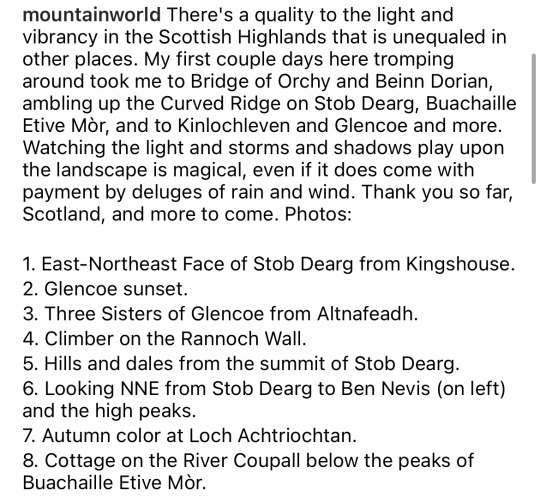
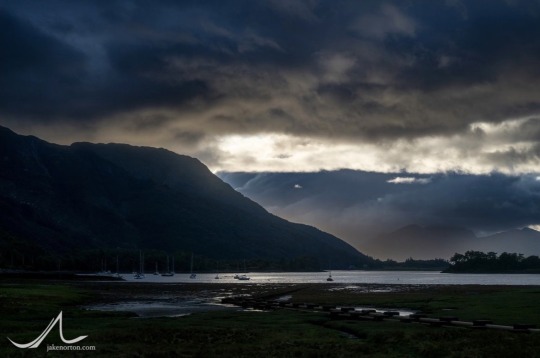
2. Glencoe sunset.

3. Three Sisters of Glencoe from Altnafeadh.
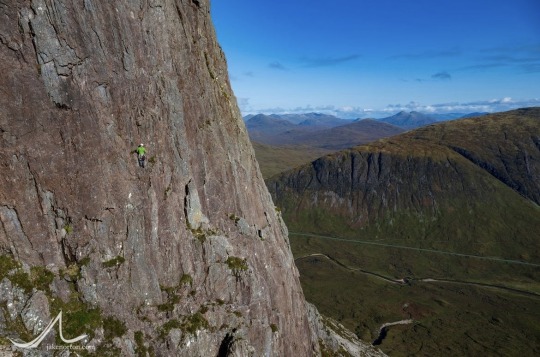
4. Climber on the Rannoch Wall.
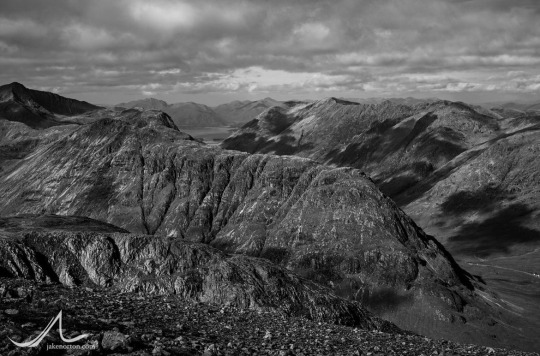
5. Hills and dales from the summit of Stob Dearg.
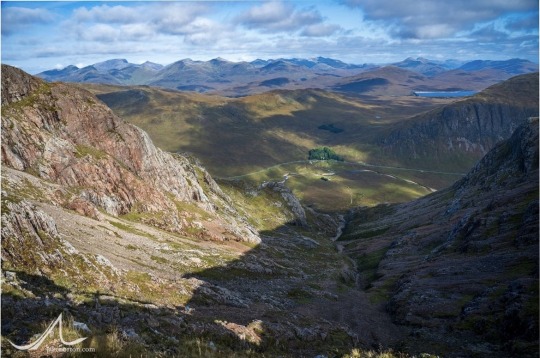
6. Looking NNE from Stob Dearg to Ben Nevis (on left) and the high peaks.

7. Autumn color at Loch Achtriochtan.

8. Cottage on the River Coupall below the peaks of Buachaille Etive Mòr.
From Kinlochleven the penultimate stop on the West Highland Way and an important tourism destination in the Highlands.
13 notes
·
View notes
Text
showed my grandmother a map of this place and she pointed to a bit of water and was like is that loch rannoch and i looked it up and was like yes and she was like “i could tell by the shape”
2 notes
·
View notes
Text
Sonntag, 3. September 2023, 12 Uhr, Loch Laidon
Loch Laidon liegt im dunklen Kern Schottlands, etwa gleich weit weg von Ben Nevis und Schiehallion, man kann von hir aus praktisch alles zu Fuss erreichen. Wenn man sehr viel Zeit hat. Oder schwimmend. Ich fange schonmal an, mit den ersten drei oder vier Schwimmzügen. Braunes Wasser, mit weichem Grund, der nach wenigen Metern zu tief zum Stehen ist. Wir haben den fotogenen Strand zwar besucht, aber zum Baden war es dort zu sandig. Stattdessen sind wir an einer Bootseinfahrt gelandet. Auf dem Rücken liegen und beim Drehen im Wasser die flache Einöde von Rannoch Moor betrachten, und dahinter am Horizont die umliegenden Berge. Das Loch ist deutlich wärmer als der Bach von gestern, es fühlt sich so an, als könnte ich endlos baden. Mache ich natürlich nicht, soviel Zeit hat ja niemand. Abends noch ein kurzes Bad im besten Pool der Welt. Eine unerklärte Schwäche verschwindet sofort mit dem Betreten des kalten Wassers.
4 notes
·
View notes
Text
Day 10 Glasgow to Avimore
Banks of Loch Lomond via wild Rannoch Moor, Glen Coe, Fort William, beneath Ben Nevis and Fort Augustus. Then to Loch Ness on the way to Culloden Moor where Jacobite rising, with Bonnie Prince Charlie at its helm came to a tragic end at hands of the Hanoverians. Overnight at Avimore.







2 notes
·
View notes
Text
Musings from the (G)lens
Our Scottish adventure started well with a good drive up on Friday and some satisfying photography around Loch Tulla and Rannoch Moor before heading for the cottage. Saturday morning saw us trying to avoid weekend day trippers but as we passed over Rannoch Moor the light was such that we had to pull over and grab our cameras. Reflections – Rannoch Moor It got me thinking about the approach to…

View On WordPress
0 notes
Text
You Feel Your Life as a Weekend
Izumi Shikibu, André Gide, Annie Dillard, et al.: 'You Feel Your Life as a Weekend'
[Image: “Misty Morning, Loch Rannoch 6,” by a Flickr user with the handle “xylophilist” (Gr: wood lover.) The original photo is here; I’m pretty sure the photographer is one Tim Haynes, whose Web site is here. I use this photo today under the terms of the photographer’s generous Creative Commons license; thank you!] From whiskey river’s commonplace book: Things I Want Decided Which shouldn’t exist in this world, the one who forgets or the one who is forgotten?...
[Read the rest]
#Jane Hirshfield#Annie Dillard#Margaret Atwood#Philip Levine#André Gide#change#life and death#nature#Izumi Shikibu#living anew#the little things#Tim Haynes
1 note
·
View note
Text
Curiously Jamie Roy was in the same hotel at the Loch Rannoch Hotel last night!




Now... let the theories begin ^^
29 notes
·
View notes
